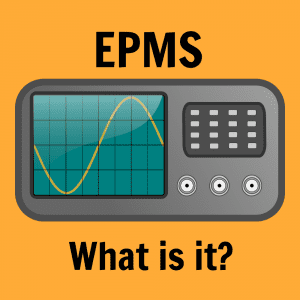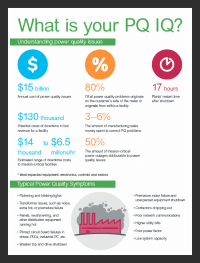EPMS provides the feedback facilities need to reduce inefficiencies related to power delivery and energy consumption.

By: Allan Evora
Electricity should never be treated as a fixed expense. Electricity is a variable expense based on production levels, headcount, season and other factors depending on the type of facility. It’s crucial to measure and monitor your electricity, just like you would any other variable expense. There can be a cost associated with poor quality of power: unexpected downtime, damage to sensitive equipment, or even-worse: safety risks.
An EPMS (Electrical Power Management System) is a valuable tool that allows an owner to have peace of mind when it comes to their power and energy systems. It’s a tool you can use to not only manage capacity and visualize how electricity is distributed throughout your facility, but also analyze historical data to find any power problems and adjust based on your findings. It provides very granular, real-time information from your equipment and environment, allowing you to assess and respond to abnormal conditions in a timely manner.
Where did EPMS come from?
Prior to the 1990’s, facilities had limited management capabilities into electric power.
Mission critical facilities had always known that loss of power and poor power quality had a significant impact to their bottom lines. But only when they brought the demand for visibility into their electrical distribution network to OEMs like GE, Eaton, and Siemens did EPMS really take off.
Electrical distribution equipment in industrial plants and commercial facilities started coming with smart communicating devices like protective devices, energy meters, power quality meters, and power quality analyzers.
Those meters gave facility owners the capability to monitor certain electrical assets, such as switchgear, transformers, generators, and uninterruptable power supply systems.
Facility owners needed a system that tied everything together in a single interface, and thus the EPMS was born. In many ways, the EPMS provides similar benefits to the facility owner as a SCADA and distribution management system provides to an electrical utility.
What can EPMS help facilities discover?
Building automation systems that control and monitor HVAC and lighting are often referred to as energy management systems or utility management systems. In most cases, this is a misnomer. To properly manage electrical resources, you need detailed information about both the power consumption and demand as well as pricing signals and power delivery quality. Without real-time and historical feedback from your electrical distribution, you cannot properly manage your electricity and its associated costs.
When EPMS is combined with information from your other building systems, whether it be your HVAC systems or process control systems, this tool allows owners to take control of their power and energy costs.
Having an EPMS system allows you to identify and isolate larger consumers of electricity inside your facility. This enables you to reduce inefficiencies and waste related to energy consumption.
In addition, the visibility you get within an EPMS system can help root cause and remedy power problems in a cost effective and timely manner.
Specifically, EPMS helps facility managers and engineers become a little more proactive about issues like:
- Cost allocation: Most of today’s electrical switchgear come with metering capability built into the equipment. The same protective devices that tell a circuit breaker when to trip can also communicate the power and energy data to an EPMS system. This provides high level visibility to allow allocation by department, product, or facility system without having to invest in a large number of submeters.
- Capacity: An EPMS can tell you if you’re exceeding the capacity of a circuit. This is especially helpful if you’re planning on connecting a new machine to the electrical system.
- Power quality sags/swells/harmonics/transients: Power quality issues have a huge impact on sensitive electronics, which can’t tolerate spikes in power or large harmonics. Having an EPMS with high-end meters (like power quality meters and power quality analyzers) allows you to determine whether you’ve got potential risk in terms of equipment going offline as a result of poor quality.
RELATED: Think you need an EPMS system? Read this first.
EPMS: More advanced functionality than SCADA
An EPMS is a specialized SCADA system, geared toward electrical distribution. Many functions performed within an EPMS system are similar to a SCADA system, such as:
- Custom graphics
- Real time displays
- Alarming capabilities
- Trending
- Reporting
But some of the analysis functions an EPMS can provide are very difficult to replicate in SCADA, like power quality analysis, waveform analysis, or sequence of events recording.
Sequence of events recording
Sequence of events recording is synchronizing the timestamp between all devices in your EPMS system (meters, relays, equipment monitors, PLCs). That minute level of resolution is critically important when trying to root cause an event. In an electrical system, the timeframe in which an entire series of events can occur might be less than 1 second. Since everything is timestamped in sequence of events, you’re able to drilldown to the microsecond level.
Waveform
Another capability that generic SCADA software can’t provide, and typically has to be provided by an OEM, is waveform. Waveforms allow you to look at electricity at a very high resolution, allowing you to see anomalies in the cycle of electricity. These cycles of electricity allow you to measure sags and swells above normal levels, and detect transients.
Two ways to integrate EPMS
There are two distinct approaches to integrating EPMS. Neither is right or wrong, and there are pros and cons to both.
The first approach is to go with a pre-created EPMS system developed by the companies who also manufacture high-end electrical distribution equipment like GE, Eaton, Siemens, Russelectric, or Asco. These EPMS are somewhat self-contained and proprietary, based on the OEM you decide to go with. I recommend this route for those who need high-end meters that give data like power quality, waveform, sag/swell, and harmonics.
The second approach is consulting and contracting with a systems integrator to customize a solution that integrates into a SCADA system. If you’re just looking for basic electric parameters, this is the way to go. If you already have, or wish to install a SCADA system, it’s nice to be able to see all monitoring data (including power quality data) through one pane of glass. Electric equipment often comes with its own graphical UI, trending, and reporting capabilities. Integrators use those graphics and open communications protocols to make the EPMS communicate to whatever SCADA system you chose.
Obviously, the advantage of having a proprietary, all-inclusive system from the manufacturer is that it works in a more seamless fashion.
The benefit of a customized, open system is that you can pick and choose which equipment to integrate into your system. The SCADA approach also tends to be a better fit in a retrofit environment. Since retrofit environments have a mix of different products and systems, you probably don’t want to spend a lot of money replacing existing equipment to make it all the same flavor.
Incorporating EPMS into your O&M process
EPMS isn’t just about the magnitude of energy used, but also how it relates to other drivers in your organization. A well-designed EPMS system can be connected to other corporate systems, like accounting, production, ticketing, building automation, and enterprise systems like work order and network management.
Why would you want to connect your energy system to other systems, like production?
To maximize energy usage, your production team may need to adjust energy per unit produced. Your EPMS can simply share the data it’s analyzed, or direct critical alarms to help the team make wiser business decisions. Without an EPMS, your production system wouldn’t have the data to make informed decisions about energy related to current production levels.
Here’s a great example of a proper installation of EPMS.
Say you’re a data center that monitors fans on their transformers. You can configure your EPMS to send alarm messages related to those fans to the work order management system that would automatically print a work order. Instead of manually generating a work order, the EPMS would allow you to automatically flag a technician or electrician to investigate the problem.
Example of an EPMS in action
Say a facilities manager notices the electric bill was higher than normal last month. Is it the HVAC system? Lighting system? Receptacles?
He might have a building automation system that could possibly show if one of those cost centers has been the culprit, but a building automation system wouldn’t provide adequate data to determine why.
Luckily, he has submeters installed, and is able to allocate electrical costs by system, process, or tenant. In addition, he has an EPMS that allows him to see and trend collected information from both submeters and building automation system on one screen.
From EPMS data, the facilities manager realizes the culprit is the lighting system. He remembers there was an event outside normal business hours that required the lighting system to be overridden. Instead of running from 9am to 5pm, it’s been running until 8pm for the last month. Looks like he forgot to take the lighting system off override.
It may seem like a simple example, but through data collected by the EPMS, we actually see situations like this more often than you might think.
The value of EPMS
EPMS is extremely valuable to mission-critical facilities concerned with crippling downtime. By staying on top of electrical distribution, trends and analysis can alert to any power quality issues before they turn into big problems.
To reiterate, an EPMS helps:
- Manage electricity capacity
- Analyze the quality of power in your facility
- Explain how energy is consumed
- Optimize your facility
Talk to Affinity Energy to learn more about an EPMS for your environment.
Allan D. Evora
Allan D. Evora is a leading expert in control systems integration and has worked in every capacity of the power and energy management project lifecycle. With over 25+ years of industry experience, he has worked at Boeing Company and General Electric before establishing Affinity Energy, Charlotte, NC in 2002. Allan is an alumnus of Syracuse University with a B.S. in Aerospace Engineering, a graduate of the NC State Energy Management program, and qualified as a Certified Measurement & Verification Professional (CMVP).
Throughout his career, Allan has demonstrated his passion for providing innovative solutions. In 1990, he developed FIRST (Fast InfraRed Signature Technique), a primary design software tool used to rapidly assess rotary craft infrared signatures. In 2008, Allan was instrumental in developing Affinity Energy's Utilitrend, a commercially available, cloud-based utility resource trending, tracking, and reporting software.
Additionally, Allan has been instrumental in large-scale integration projects for energy companies and mission critical facilities, such as data centers, hospitals, airports, and manufacturing. He has worked with SCADA systems since the early '90s and has a passion for instrumentation, controls, and actionable information, which drives him to incorporate openness, simplicity, and integrity into every design.

